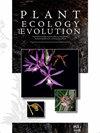阿莫里米亚及其亲缘植物花粉粒形态的演化证明了孢粉单形和同形在麻瓜科系统分类中的重要性
IF 1.3
4区 生物学
Q3 PLANT SCIENCES
引用次数: 0
摘要
背景与目的——花粉粒形态是帮助开花植物分类学的重要形态学特征。对于malpiighiaceae,只有一项未发表的孢粉学研究对该科目前公认的75个属中的60个进行了全面采样。为了测试阿莫里米亚及其亲缘系花粉形态的系统相关性,我们对这些谱系的花粉形态进行了表征。我们对阿莫里米亚及其盟友的最新分子系统发育进行了评分、编码并绘制了12个字符。材料与方法:本研究取样了13种阿莫里米亚属(Amorimia)为内类群,2种Mascagnia和Ectopopterys soejartoi为外类群。用光学显微镜和扫描电子显微镜对花粉颗粒进行乙酰化、表征和测量。花粉定量测量提交PCA多变量分析。此外,还对数量性状和质量性状进行了评分和编码,并绘制了12个性状的分子系统发育图谱。关键结果-阿莫里米亚及其同属植物是窄孢的,因为所有物种都显示相同的花粉类型,花粉颗粒之间存在一些微妙的差异,例如纹饰,形状,大小和花粉外壁厚度的细节。然而,花粉粒的进化模式表明,很少有定性和非胚性性状能用于属内(即孔型和孔数)的区分,而几乎所有的定量和同形性状都能用于属内水平的区分。结论:我们的研究结果表明,尽管阿莫里米亚属及其亲缘属的花粉形态特征表现出细微的差异,但在系统发育背景下分析时,定性和定量的非胚性和/或同质性特征对malpiighiaceae属内和属内水平具有很高的信息。本文章由计算机程序翻译,如有差异,请以英文原文为准。
Evolution of pollen grain morphology in Amorimia and allies evidences the importance of palynological apomorphies and homoplasies in Malpighiaceae systematics
Background and aims – Pollen grain morphology is an important morphological character for aiding the systematics of flowering plants. For Malpighiaceae, only a single unpublished palynological study has comprehensively sampled ca 60 of this family’s 75 currently accepted genera. To test the systematic relevance of pollen morphology in Amorimia and allies, we characterised the pollen morphology of these lineages. We scored, coded, and mapped 12 characters onto the most recent molecular phylogeny of Amorimia and allies. Material and methods – We sampled 13 species of Amorimia as ingroup and two species of Mascagnia and Ectopopterys soejartoi as outgroup. Pollen grains were acetolised, characterised, and measured using light microscopy and scanning electron microscopy. Pollen quantitative measurements were submitted to a PCA multivariate analysis. Additionally, quantitative and qualitative characters were scored and coded into 12 characters and mapped onto the molecular phylogeny of Amorimia and allies. Key results – Amorimia and allies are stenopalynous due to all species showing the same pollen type, with some subtle differences between the pollen grains, such as details of ornamentation, shape, size, and thickness of the pollen exine. However, the patterns of pollen grain evolution showed that few qualitative and apomorphic characters are informative for intrageneric distinction (i.e. type and number of apertures), and almost all quantitative and homoplastic characters analysed were informative at infrageneric levels within Malpighiaceae. Conclusion – Our results demonstrate that even though the pollen morphology characters of Amorimia and allies show subtle variation, both qualitative and quantitative apomorphic and/or homoplastic characters are highly informative for intra- and infrageneric levels in Malpighiaceae when analysed in a phylogenetic context.
求助全文
通过发布文献求助,成功后即可免费获取论文全文。
去求助
来源期刊

Plant Ecology and Evolution
PLANT SCIENCES-
CiteScore
2.20
自引率
9.10%
发文量
27
审稿时长
>12 weeks
期刊介绍:
Plant Ecology and Evolution is an international peer-reviewed journal devoted to ecology, phylogenetics and systematics of all ‘plant’ groups in the traditional sense (including algae, cyanobacteria, fungi, myxomycetes), also covering related fields.
The journal is published by Meise Botanic Garden and the Royal Botanical Society of Belgium.
 求助内容:
求助内容: 应助结果提醒方式:
应助结果提醒方式:


